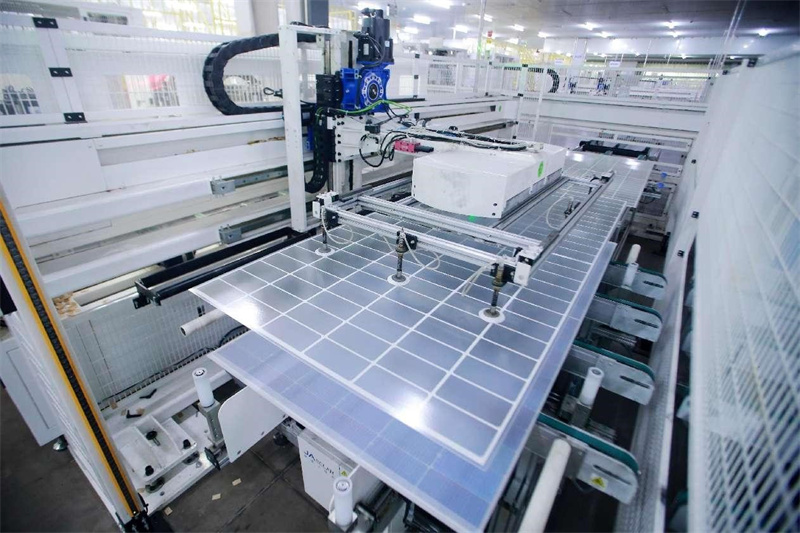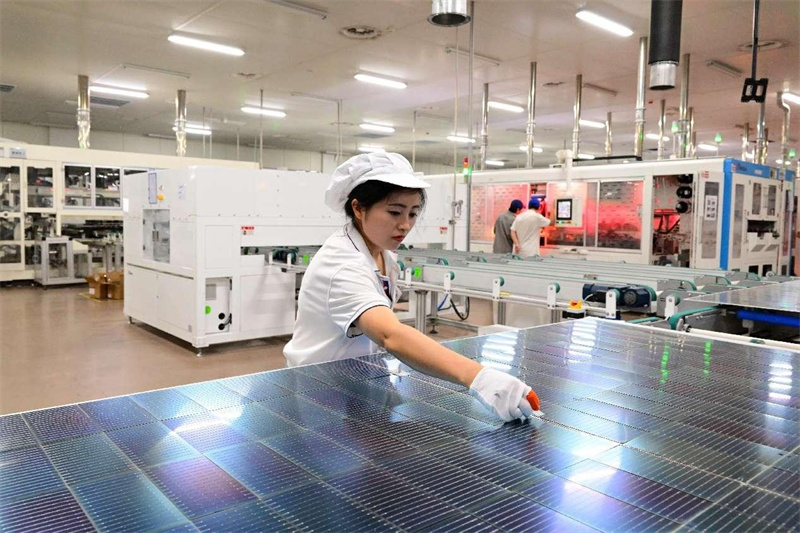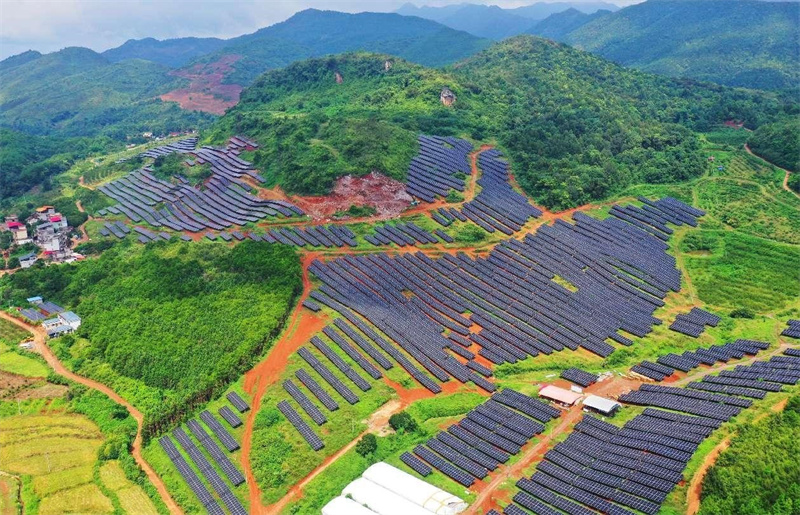China's PV industry continues to rise, thanks to technological innovation

Industrial robots move PV modules in a workshop of a new energy company based in Yangzhou, east China's Jiangsu province. [Photo by Meng Delong/People's Daily Online]
China's photovoltaic (PV) industry maintained robust growth momentum during the first six months of this year. Data showed that during this period, the country's output of polysilicon, silicon wafers, solar cells, and modules all rose by over 30 percent year-on-year, and exports of PV modules increased by nearly 20 percent from the same period last year.
This growth is evident at a granular silicon production facility of Chinese major polysilicon supplier GCL Technology Holdings Limited in Xuzhou, east China's Jiangsu province, where a huge number of small granular silicon particles are flowing into storage tanks, ready for quality checks and packaging.
"Granular silicon, a type of polycrystalline silicon and an essential material component in the PV manufacturing industry, has advantages such as smaller volume and simpler production processes," said Lan Tianshi, co-chief executive officer of the company.
He said that the company's four facilities for producing granular silicon in China are all running smoothly, with a steady increase in their market share.
The demand for PV systems continues to rise globally as the world increasingly shifts toward renewable energy, said Liu Yiyang, deputy secretary-general and spokesperson of the China Photovoltaic Industry Association.
In the first half of this year, the newly installed capacity of China's PV industry reached 102.48GW, including 49.6 GW of centralized PV installations, 37.03 GW of commercial and industrial solar installations, and 15.85 GW of residential solar installations.
"China has made significant achievements in multiple segments of the PV industry, including solar cells, modules, and silicon wafers," said Liu.
"Thanks to Chinese PV companies' continuous technological innovation, enhanced independent R&D, and improved production efficiency, China leads the world in PV output and capacity, and multiple segments of the industrial chain," he added.

A woman works in a workshop of new energy company Ronma Solar in Jinhua, east China's Zhejiang province. [Photo by Shi Bufa/People's Daily Online]
Looking back, China's PV industry went through a tough time when it relied heavily on foreign sources for raw materials, equipment, and markets.
From the early 2000s to late 2010, there was a remarkable increase in China's solar cell production. Yet the industry, which was primarily export-oriented at the time, faced serious challenges due to the global financial crisis.
In the 2010s, the global PV industry encountered additional difficulties caused by the so-called anti-dumping and anti-subsidy measures enforced by some countries. In response to these challenges, the Chinese PV industry shifted its focus toward expanding the Chinese domestic market and developing core technologies.
Throughout the years, driven by China's dual carbon goals of peaking carbon emissions by 2030 and achieving carbon neutrality by 2060, Chinese PV companies have intensified their R&D efforts. They have successfully developed and applied emerging technologies like perovskite PV cell technology, while also promoting the large-scale commercialization of multiple high-efficiency cell technologies, Liu said.
Liu noted that in 2023, all of the world's top 10 companies in PV cells production were from China, with a combined capacity of 681.2 GW, accounting for 66 percent of the global total.
According to the white paper "China's Energy Transition" recently released by China's State Council Information Office, China has built complete industrial chains for the R&D, design, and integrated manufacturing of wind and solar PV equipment, and the high conversion efficiency of crystalline silicon/perovskite PV cell technology has established multiple world bests.
Over the past decade, China has provided premium clean energy products and services to the international market. The country has also doubled its efforts in technological innovation to upgrade new energy technology at a faster pace, contributing enormously to a sharp reduction in the costs of wind power and PV power worldwide.

Photo shows a solar farm in Tushi township, Lanshan county, Yongzhou, central China's Hunan province. [Photo by Huang Chuntao/People's Daily Online]
Data from the International Energy Agency show that in 2023, China's newly installed renewable energy capacity exceeded the total of other regions worldwide, making it the largest contributor to the development of the global renewable energy industry.
To address the challenges the industry faces such as intense competition, export obstacles in some regions, and a slight supply-demand imbalance, some leading Chinese companies are increasing investment in technological upgrades to reduce costs, maintain profits, and improve efficiency, while some others are seeking new growth opportunities and expanding their global presence.
Since the beginning of this year, companies like GCL Technology Holdings Limited, Trina Solar, and JinkoSolar have announced to launch PV projects in Middle East. Some firms are accelerating their global expansion by assisting their overseas counterparts in localizing industrial chains.
"No matter how the market changes, innovation remains our top priority as technological strength and independent innovation capabilities are always crucial for maintaining our resilience and competitiveness," said Lan.
























